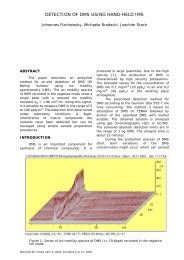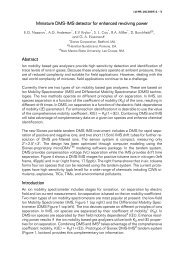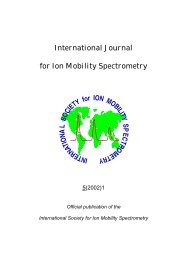ion mobility spectrometry of peroxide explosives tatp and hmtd
ion mobility spectrometry of peroxide explosives tatp and hmtd
ion mobility spectrometry of peroxide explosives tatp and hmtd
Create successful ePaper yourself
Turn your PDF publications into a flip-book with our unique Google optimized e-Paper software.
ION MOBILITY SPECTROMETRY OF PEROXIDE EXPLOSIVES TATP AND<br />
HMTD<br />
Andrew J. Marr <strong>and</strong> David M. Groves<br />
Defence Science <strong>and</strong> Technology Laboratory (Dstl), Fort Halstead, Sevenoaks, Kent, TN14 7BP,<br />
United Kingdom.<br />
Abstract<br />
The <strong>ion</strong> <strong>mobility</strong> <strong>and</strong> mass spectra <strong>of</strong><br />
TATP (triacetone tri<strong>peroxide</strong>) <strong>and</strong> HMTD<br />
(hexamethylene tri<strong>peroxide</strong> diamine) have<br />
been recorded in both positive <strong>and</strong> negative<br />
<strong>ion</strong> mode using a gas chromatograph-<strong>ion</strong><br />
<strong>mobility</strong> spectrometer-mass spectrometer<br />
(GC-IMS-MS). The effects <strong>of</strong> temperature,<br />
humidity, dopant concentrat<strong>ion</strong> <strong>and</strong> analyte<br />
concentrat<strong>ion</strong> have been investigated. Dopant<br />
concentrat<strong>ion</strong> <strong>and</strong> temperature were found to<br />
have significant effects on the spectra <strong>of</strong> both<br />
compounds. TATP was very sensitive to<br />
detect<strong>ion</strong> in positive <strong>ion</strong> mode employing a<br />
signal correlating to a molecular <strong>ion</strong> species.<br />
However, it was found to be effectively<br />
undetectable at trace levels in negative <strong>ion</strong><br />
mode. HMTD spectra were observed in both<br />
<strong>ion</strong> modes.<br />
Introduct<strong>ion</strong><br />
The organic <strong>peroxide</strong>s triacetone<br />
tri<strong>peroxide</strong> (TATP) <strong>and</strong> hexamethylene<br />
tri<strong>peroxide</strong> diamine (HMTD) are highly<br />
sensitive primary <strong>explosives</strong> (structures are<br />
shown in Figure 1). The ease <strong>of</strong> manufacture<br />
<strong>of</strong> these compounds from readily obtainable<br />
domestic <strong>and</strong> industrial products, coupled with<br />
explosive power <strong>and</strong><br />
ease <strong>of</strong> initiat<strong>ion</strong> has<br />
resulted in their usage in H<br />
O O<br />
3 C<br />
improvised <strong>explosives</strong> C<br />
devices. In 2001, H 3 C<br />
Richard Reid, the socalled<br />
‘Shoe Bomber’,<br />
O<br />
O<br />
used TATP as an<br />
C<br />
improvised detonator in<br />
his attack on an<br />
American Airlines flight.<br />
Ion <strong>mobility</strong> TATP<br />
<strong>spectrometry</strong> (IMS) is<br />
the core technology underpinning the majority<br />
<strong>of</strong> trace explosive detect<strong>ion</strong> systems. Previous<br />
work has indicated that TATP <strong>and</strong> HMTD can<br />
be detected using IMS but the results were<br />
limited [2,3]. The aim <strong>of</strong> this research was to<br />
identify the nature <strong>of</strong> the product <strong>ion</strong> peaks<br />
(PIPs) for TATP <strong>and</strong> HMTD using IMS/MS <strong>and</strong><br />
to study the behaviour <strong>of</strong> these <strong>ion</strong>s as a<br />
funct<strong>ion</strong> <strong>of</strong> the sample concentrat<strong>ion</strong> <strong>and</strong> the<br />
internal temperature, humidity <strong>and</strong> dopant<br />
concentrat<strong>ion</strong> <strong>of</strong> the system.<br />
Experimental<br />
A GC-IMS-MS system was assembled by<br />
attaching a Perkin Elmer Autoscan GC to a<br />
PCP IMS-MS via a heated transfer line that<br />
contained an extens<strong>ion</strong> <strong>of</strong> the capillary<br />
column. A 5 m long, narrow bore (250 mm<br />
inner diameter) column was used with a HP 5<br />
(95 % methyl siloxane / 5% phenylsiloxane)<br />
stat<strong>ion</strong>ary phase with helium as the carrier<br />
gas. The injector temperature was set at 175<br />
×C. The oven temperature was set at 55 ×C<br />
for TATP <strong>and</strong> 120 ×C for HMTD <strong>and</strong> remained<br />
constant throughout sample elut<strong>ion</strong><br />
(isothermal condit<strong>ion</strong>s). The end <strong>of</strong> the<br />
column was posit<strong>ion</strong>ed so samples were<br />
CH 3<br />
C<br />
CH 3<br />
O<br />
N<br />
O<br />
H 3 C CH 3<br />
Figure 1: Structures <strong>of</strong> HMTD <strong>and</strong> TATP<br />
CH 2<br />
CH 2<br />
O<br />
O<br />
O<br />
O<br />
CH 2<br />
CH 2<br />
CH 2 O O CH 2<br />
HMTD<br />
N<br />
Received for review June 6, 2003, Accepted July 15, 2003
60 - Ion Mobility Spectrometry <strong>of</strong> Peroxide Explosives TATP <strong>and</strong> HMTD<br />
directly injected into the <strong>ion</strong>isat<strong>ion</strong> source<br />
reg<strong>ion</strong> <strong>of</strong> the IMS.<br />
Samples <strong>of</strong> TATP <strong>and</strong> HMTD in solut<strong>ion</strong><br />
(acetone <strong>and</strong> chlor<strong>of</strong>orm) were manually<br />
injected into the GC <strong>and</strong> upon elut<strong>ion</strong> from<br />
the column were entrained in a carrier gas<br />
(air) flowing at 100 <strong>and</strong> 200 cm3/min. A<br />
counter flow <strong>of</strong> air at 500 cm3/min entered<br />
from the detector end <strong>of</strong> the drift cell. A<br />
dopant could be added to the carrier flow<br />
prior to it entering the IMS system. Ammonia<br />
(NH3) <strong>and</strong> dichloromethane (CH2Cl2) were<br />
used as dopants in positive <strong>and</strong> negative <strong>ion</strong><br />
mode, respectively. It was also possible to<br />
minimise dopant concentrat<strong>ion</strong>s by<br />
preventing their addit<strong>ion</strong> to the carrier gas.<br />
The humidity <strong>of</strong> the carrier flow was<br />
monitored. Most <strong>of</strong> the studies were<br />
performed with the air relatively dry (< 10<br />
parts per mill<strong>ion</strong> by volume (PPMV)) but<br />
some measurements were made with the<br />
humidity increased by adding water vapour<br />
to the gas by passing it through a water<br />
bubbler.<br />
IMS spectra were recorded at series <strong>of</strong><br />
different IMS drift cell temperatures; 70,<br />
100, 140, 170 <strong>and</strong> 220 ×C for TATP <strong>and</strong> 70,<br />
100,150 <strong>and</strong> 200 ×C for HMTD. The electric<br />
field strength within the drift cell was<br />
maintained at 200 V/cm produced by a<br />
maximum electrode voltage <strong>of</strong> 3 kV.<br />
The collector electrode <strong>of</strong> the IMS has a<br />
¼ inch diameter hole drilled through its<br />
centre through which approximately 7% <strong>of</strong><br />
the total <strong>ion</strong> current passed. The sampling<br />
orifice (diameter 25 mm), separating the IMS<br />
from the MS reg<strong>ion</strong>s, located behind the<br />
collector surface allows only a very small<br />
fract<strong>ion</strong> <strong>of</strong> the total <strong>ion</strong> current (~10-5) to<br />
pass through for analysis by the quadrupole<br />
mass spectrometer. Mass spectra were<br />
recorded with quadrupole reg<strong>ion</strong> pressures<br />
from 5 ¥ 10-5 to 8 ¥ 10-5 Torr. Mass spectra<br />
were measured up to 500 atomic mass units<br />
(amu) with the IMS gating grids fully open.<br />
Single <strong>ion</strong> monitoring experiments were also<br />
performed. In this mode, two spectra are<br />
produced: an IMS spectrum <strong>and</strong> the selected<br />
mass <strong>ion</strong> signal as a funct<strong>ion</strong> <strong>of</strong> <strong>ion</strong> <strong>mobility</strong>.<br />
In combinat<strong>ion</strong>, these provide a means <strong>of</strong><br />
identifying the product <strong>ion</strong> peak (PIP) with<br />
which the <strong>ion</strong>s <strong>of</strong> the selected mass are<br />
associated.<br />
Results <strong>and</strong> discuss<strong>ion</strong><br />
TATP<br />
Table 1: Optimum condit<strong>ion</strong>s for TATP <strong>and</strong> HMTD IMS detect<strong>ion</strong><br />
<strong>ion</strong> mode<br />
drift cell<br />
temperature (°C)<br />
TATP could only be detected at trace<br />
levels (sub mg) levels in positive <strong>ion</strong> mode.<br />
humidity<br />
(PPM V )<br />
dopant<br />
condit<strong>ion</strong>s<br />
PIP identity<br />
TATP positive 100 < 100 none (TATPNH 4 ) +<br />
b)<br />
a)<br />
RIP<br />
Acetone +<br />
m/z = 58<br />
((TATP)•NH 4 ) +<br />
m/z = 240<br />
12 18 24 30<br />
drift tim e / m s<br />
Figure 2: IMS spectra <strong>of</strong> TATP recorded at<br />
100 oC at low humidity (< 10 PPMV) a) in<br />
the presence <strong>of</strong> ammonia dopant <strong>and</strong> b)<br />
with dopant levels minimised.<br />
HMTD<br />
negative 150
Ion Mobility Spectrometry <strong>of</strong> Peroxide Explosives TATP <strong>and</strong> HMTD - 61<br />
TATP spectra is characterised by the<br />
presence <strong>of</strong> two PIPs;<br />
an adduct <strong>of</strong> the molecular <strong>ion</strong>, m/z<br />
240, K 0 = 1.36 tentatively identified as<br />
(TATPNH4)+, <strong>and</strong><br />
an <strong>ion</strong> with m/z 58, K 0 = 2.32,<br />
tentatively identified as the acetone<br />
molecular <strong>ion</strong>.<br />
In the presence <strong>of</strong> ammonia dopant the<br />
m/z 58 <strong>ion</strong> is the most dominant PIP but<br />
when the dopant concentrat<strong>ion</strong> is minimised<br />
the larger <strong>ion</strong> becomes dominant as is shown<br />
in Figure 2. This suggests the TATP reacts<br />
with the ammonia causing molecular<br />
fragmentat<strong>ion</strong> but the mechanism for this<br />
react<strong>ion</strong> has not been established. Increasing<br />
the temperature caused a similar but less<br />
pronounced effect reducing the intensity <strong>of</strong><br />
the molecular adduct <strong>ion</strong>. In this case it was<br />
possible to observe fragmentat<strong>ion</strong> <strong>of</strong> the<br />
molecular adduct <strong>ion</strong> within the drift cell.<br />
At higher temperatures (> 130 ×C) the<br />
molecular adduct <strong>ion</strong> PIP is not present but<br />
two addit<strong>ion</strong>al peaks, m/z 73, K 0 = 2.28 <strong>and</strong><br />
m/z 89, K 0 = 2.18, are observed. The effect<br />
<strong>of</strong> the dopant is less significant but its<br />
presence still increases the intensity <strong>of</strong> the<br />
lowest mass <strong>ion</strong> (m/z 58) at the expense <strong>of</strong><br />
the larger <strong>ion</strong>s.<br />
Increasing the humidity <strong>of</strong> the carrier<br />
gas had some effect on the sensitivity <strong>of</strong> the<br />
system. This was most noticeable at lower<br />
temperatures when ammonia dopant<br />
concentrat<strong>ion</strong> was higher.<br />
Optimum sensitivity for detect<strong>ion</strong> <strong>of</strong><br />
TATP was obtained at an IMS temperature <strong>of</strong><br />
100 ×C, with dopant concentrat<strong>ion</strong> minimised<br />
<strong>and</strong> humidity low (< 100 PPMV) employing<br />
the m/z 240 PIP. However, relatively<br />
sensitive detect<strong>ion</strong> was achievable over a<br />
range <strong>of</strong> temperatures <strong>and</strong> dopant<br />
condit<strong>ion</strong>s.<br />
HMTD<br />
HMTD produced complex IMS spectra in<br />
both positive <strong>and</strong> negative <strong>ion</strong> modes. In<br />
positive <strong>ion</strong> mode at lower temperatures (<<br />
130 ×C) molecular adduct <strong>ion</strong>s, m/z 209, K 0<br />
= 1.50 <strong>and</strong> m/z 226, K 0 = 1.49, were<br />
observed. At temperatures above 100 ×C<br />
PIPs associated with fragment <strong>ion</strong>s were also<br />
observed. The two most significant fragment<br />
PIPs were associated with m/z 90, K 0 = 2.10<br />
<strong>and</strong> m/z 145, K 0 = 1.73. As was observed for<br />
TATP, increasing the temperature <strong>and</strong> the<br />
presence <strong>of</strong> ammonia dopant caused a<br />
reduct<strong>ion</strong> in the intensity <strong>of</strong> the molecular<br />
<strong>ion</strong>s <strong>and</strong> an increase in the intensity <strong>of</strong> the<br />
fragment <strong>ion</strong> PIPs. In addit<strong>ion</strong> to fragment<br />
<strong>ion</strong>s a HMTD PIP associated with a m/z 224,<br />
K 0 = 1.49 <strong>ion</strong> was also observed at higher<br />
temperatures (130 ×C). This <strong>ion</strong> was<br />
tentatively identified as an adduct <strong>of</strong> the<br />
dialdehyde form <strong>of</strong> HMTD produced by the<br />
cleavage <strong>of</strong> one <strong>of</strong> the O-O bonds. This <strong>ion</strong><br />
was more thermally stable than the<br />
molecular <strong>ion</strong> adducts <strong>and</strong> had significant<br />
intensity at 220 ×C.<br />
In negative <strong>ion</strong> mode all HMTD PIPs<br />
were associated with fragment <strong>ion</strong>s. From the<br />
GC elut<strong>ion</strong> times it could be shown that these<br />
were produced from products <strong>of</strong> thermal<br />
degradat<strong>ion</strong> <strong>of</strong> HMTD within the GC. The main<br />
<strong>ion</strong>s observed were associated with the m/z<br />
138/140/142 which were identified as the<br />
chloride adducts <strong>of</strong> the protonated <strong>and</strong><br />
oxidised forms <strong>of</strong> radicals produced by<br />
cleavage <strong>of</strong> the three O-O bonds,<br />
N(CH2O)3H²Cl- <strong>and</strong> N(CH2O)2(CHO)²Cl-<br />
(both K 0 = 1.88), which agrees with results<br />
from a previous study [1]. When the chloride<br />
dopant concentrat<strong>ion</strong> was minimised<br />
addit<strong>ion</strong>al non-chloride adduct PIPs were also<br />
observed, m/z 72, K 0 = 2.42 <strong>and</strong> m/z 150, K 0<br />
= 1.82.<br />
Sensitive detect<strong>ion</strong> <strong>of</strong> HMTD was<br />
achieved in both <strong>ion</strong> modes. The optimum<br />
condit<strong>ion</strong>s were in negative mode at an IMS<br />
temperature <strong>of</strong> 150 ×C, in the presence <strong>of</strong><br />
chloride dopant at low humidity levels (< 100<br />
PPMV). In positive mode, detect<strong>ion</strong> was best<br />
achieved with ammonia dopant concentrat<strong>ion</strong><br />
minimised at low humdity levels (< 100<br />
PPMV) at temperatures <strong>of</strong> 100 to 130 ×C.<br />
However, without a full assessment <strong>of</strong> the<br />
thermal degradat<strong>ion</strong> effects that occurred in<br />
the GC these results are only preliminary.<br />
Conclus<strong>ion</strong>s<br />
An examinat<strong>ion</strong> <strong>of</strong> the IMS spectra <strong>of</strong><br />
the <strong>peroxide</strong> <strong>explosives</strong> TATP <strong>and</strong> HMTD over<br />
a range <strong>of</strong> parameters has produced a series<br />
<strong>of</strong> complex spectra. The optimum condit<strong>ion</strong>s<br />
determined for their detect<strong>ion</strong> are<br />
summarised in Table 1.<br />
The TATP results provide clear evidence<br />
that trace detect<strong>ion</strong> <strong>of</strong> TATP is only feasible in<br />
positive <strong>ion</strong> mode, contradicting previous<br />
Copyright © 2003 by Internat<strong>ion</strong>al Society for Ion Mobility Spectrometry
62 - Ion Mobility Spectrometry <strong>of</strong> Peroxide Explosives TATP <strong>and</strong> HMTD<br />
studies. Sensitive HMTD detect<strong>ion</strong> was<br />
possible in both modes.<br />
References<br />
[1] ‘Investigat<strong>ion</strong> <strong>of</strong> the Thermal Decomposit<strong>ion</strong><br />
<strong>of</strong> TATP <strong>and</strong> HMTD by Ion Mobility<br />
Spectrometry/Mass Spectrometry’, Cho I.,<br />
Chamberlain T. Brunk S., Gill R., <strong>and</strong><br />
LaMonica D., Proceedings <strong>of</strong> the 3rd<br />
Internat<strong>ion</strong>al Aviat<strong>ion</strong> Security Technology<br />
Symposium, Atlantic City, Nov 2001.<br />
[2] Kuja F; Grigoriev A. Debono R <strong>and</strong> Nacson S,<br />
Proceedings <strong>of</strong> the 7th Internat<strong>ion</strong>al<br />
Symposium on the analysis <strong>and</strong> detect<strong>ion</strong> <strong>of</strong><br />
<strong>explosives</strong>, Edinburgh, June 2001.<br />
[3] McGann W J, Goedecke K, Becotte-Haigh, P<br />
Neves J, <strong>and</strong> Jenkins A, ‘Simultaneous dualmode<br />
IMS detect<strong>ion</strong> system for contrab<strong>and</strong><br />
detect<strong>ion</strong> <strong>and</strong> identificat<strong>ion</strong>’ Int. J. IMS 4,<br />
144 – 147 (2001).<br />
Acknowledgements<br />
This work has been funded by the UK<br />
Department for Transport.<br />
British crown copyright 2003. Published<br />
with the permiss<strong>ion</strong> <strong>of</strong> the Defence Science<br />
<strong>and</strong> Technology Laboratory on behalf <strong>of</strong> the<br />
Controller <strong>of</strong> HMSO.<br />
Copyright © 2003 by Internat<strong>ion</strong>al Society for Ion Mobility Spectrometry
















